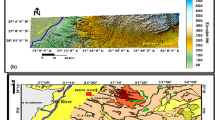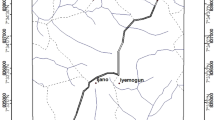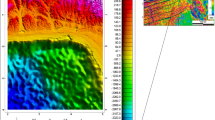Abstract
Delineating the edges of different magnetized sources represents a fundamental tool for interpreting and mapping rock boundaries of magnetic data. The present study deals with the enhancement of reduced to the pole map (RTP) of Samr El-Qaa area, North Eastern Desert, Egypt, to map deep and surface geologic contacts. The edge detection of geologic contacts is ensured by the upward continuation of reduced to the pole data at an altitude of 3 km, followed by the calculation of theta derivative and horizontal tilt angle derivative (HTAD) for RTP and upward continuation (3 km). The results obtained from the application of these techniques showed that the theta derivative delineates RTP source edges well, but the response of deeper sources is diffused. While HTAD presented well, responds to shallow and deep sources and also the edges of the sources were delineated well. HTAD showed a much sharper gradient over the edges of the magnetized sources at Samr El-Qaa area. The interpreted structural trends derived from shallow and deep Theta and HTAD maps of Samr El-Qaa territory illustrated that the most shallow dominant trends are NNE, NE, N-S, NNW, WNW, E-W and NW directions. While the deep structural ones are the ENE, NW, N-S, and E-W directions. This approach for edge detection used in this study is comprehensively applicable to other portions of the Egyptian Eastern Desert and other areas with alike geologic conditions around the world to give much sharper gradient over the edges of the magnetized sources which can be used for mineral and oil/gas exploration.














Similar content being viewed by others
References
Abdel-Rahman MA, El-Etr HA (1980) The orientational characteristics of the structural grain of the Eastern Desert of Egypt. In: El-Etr HA, Embabi NS, Youssef MSM (eds) Geologic-Geomorphic Studies in the Egyptian Deserts. Ain Shams Uni, Cairo, Egypt (Abstract), 5 p
Aero-Service (1984) Final operational report of airborne magnetic/ radiation survey in the Eastern Desert, Egypt, conducted for the Egyptian General Petroleum Corporation, Aero- Service Division, Houston. In: Western geophysical co. Taxas, USA
Ali KA, Stem RJ, Manton WI, Kimura JL, Khamees HA (2009) Geochemistry, Nd isotopes and U–Pb SHRIMP dating of Neoproterozoic volcanic rocks from the Central Eastern Desert of Egypt: new insights into the ≈750 Ma crust-forming event. Precambrian Res 171:1–22
Ammar AA, Abdel-Rahman MA, Hassanein HIE, Soliman KS (2003) Radiometric lithologic interpretation of aerial radiospectrometric false colour image maps, Eastern Desert, Egypt. Arab Gulf J Sci Res 21(1):28–47
Baranov V (1957) A new method for interpretation of aeromagnetic maps: pseudo-gravimetric anomalies. Geophysics 22:359–383
Bayoumi AI, Boctor JG (1970) Geological significance of gravity and magnetic anomalies in Rahmi area, Gulf of Suez district, U.A.R. 7th Arab Pet. Con., Secret. Gen. Leag. Arab State, Kuwait, Mar. 1970, 2 (36): B-2, 28 p
Blakely RJ, Simpson RW (1986) Approximating edges of source bodies from magnetic or gravity anomalies. Geophysics 51(7):1494–1498
Breitkreuz C, Eliwa H, Khalaf I, El Gameel K, Bühler B, Sergeev S, Larionov A, Murata M (2010) Neoproterozoic SHRIMP U–Pb zircon ages of silica-rich Dokhan volcanics in the North Eastern Desert, Egypt. Precambrian Res 182:163–174
Conoco Coral (1987) Geological map of Egypt, scale 1: 500,000, -NH36SW- Beni Suef, Egypt. The Egyptian General Petroleum Corporation, Cairo (EGPC), Egypt
Cooper GRJ (2009) Balancing images of potential field data. Geophysics 74(3):L17–L20
Cooper GRJ (2017) A tale of three filters; the tilt angle, the theta map, and sunshading. Extended Abstracts - 15th SAGA Biennial Conference & Exhibition
Cooper GRJ, Cowan DR (2006) Enhancing potential field data using filters based on the local phase. Comput Geosci 32(10):1585–1591
Dobrin MB, Savit CH (1988) Introduction to geophysical prospecting 4th Edn. McGraw Hill Book Co., New York
Dogru F, Oya Pamukcu O, Cagatay Pamukcu C (2016) Determination of mine location by using edge detection methods: a case study of Sivas-Divrigi. Earth Sci 5(4):56–61. https://doi.org/10.11648/j.earth.20160504.12
Eldosouky AM, Abdelkareem M, Elkhateeb SO (2017) Integration of remote sensing and aeromagnetic data for mapping structural features and hydrothermal alteration zones in Wadi Allaqi area, South Eastern Desert of Egypt. J Afr Earth Sci 130(2017):28–37
El-Gaby S (1983) Architecture of the Egyptian basement complex, Proceed. 5th Intern. Conf. Basement Tectonics, Cairo, Egypt.
El-Shazly EM (1966) Structural development of Egypt, U.A.R.. Abstract of the 4th Annual Meeting, Geol. Society of Egypt, Cairo, Egypt, pp. 31–38
Greiling RO, Abdeen MM, Dardir AA, El Akhal H, El Ramly MF, Kamal El Din GM, Osman AF, Rashwan AA, Rice AHN, Sadek MF (1994) A structural synthesis of the Proterozoic Arabian-Nubian Shield in Egypt. Geol Rundsch 83:484–501
Hassanein HIE, Soliman KS (2009) Aeromagnetic data interpretation of Wadi Hawashiya area for identifying surface and subsurface structures, North Eastern Desert, Egypt. JKAU: Earth Sci 20(1):117–139
Meshref WM, El-Sheikh MM (1973) Magnetic-tectonic trend analysis in northern Egypt. J Geol 17(2):179–184
Kearey P, Michael B (1994) An introduction to geophysical exploration. vol 8. Nos. 2,3 & 4. Blackwell Sciences, pp 183–190
Miller HG, Singh V (1994) Potential field tilt – a new concept for location of potential field sources. J Appl Geophys 32:213–217
Nossair LM (1981) Relation of radioactivity to fracture system in some basement rocks, North Eastern Desert, Egypt, M. Sc Thesis (Unpub.), Fac. Sci., Al-Azher University, Egypt.
Nossair LM (1987) Structural and radiometric studies on Gabal Gharib area, North Eastern Desert, Egypt, Ph.D. Thesis (Unpub.), Fac. Sci., Alexandria University, Egypt.
Oliveiraa SP, Ferreirab FJF, de Souzac J (2017) EdgeDetectPFI: an algorithm for automatic edge detection in potential field anomaly images – application to dike-like magnetic structures. Comput Geosci 103:80–91
Pilkington M, Tschirhart V (2017) Practical considerations in the use of edge detectors for geologic mapping using magnetic data. GEOPHYSICS 82(3):J1–J8 8 FIGS
Ressetar R, Monard JR (1983) Chemical composition and tectonic setting of the Dokhan volcanic formation, Eastern Desert, Egypt. J Afr Earth Sci 1:103–112
Roest WR, Verhoef V, Pilkington M (1992) Magnetic interpretation using the 3-D analytic signal. Geophysics 57:116–125
Said R (1962) The geology of Egypt. Elsevier Publ. Co., Amsterdam-New York 337 p
Sharma PV (1997) Environmental and engineering geophysics. Cambridge University Press, Cambridge
Stern RJ (1981) Petrogenesis and tectonic setting of late Precambrian enzymatic volcanic rocks, Central Eastern Desert of Egypt. Precambrian Res 16:195–230
Stern RJ, Hedge CE (1985) Geochronologic and isotopic constraints on late Pre-cambrian crustal evolution in the Eastern Desert of Egypt. Am J Sci 285:97–127
Tealeb A (1979) Predominant tectonic trends in North Egypt. Academy of Scientific Research & Technology, Helwan Institute of Astronomy and Geophysics, Bulletin No 189
Wijns C, Perez C, Kowalczyk P (2005) Theta map: edge detection in magnetic data. Geophysics 70(4):39–43
Yan TJ, Wu YG, Yuan Y, Chen L–N (2016) Edge detection of potential field data using an enhanced analytic signal tilt angle. Chin J Geophys (in Chinese) 59(7):2694–2702. https://doi.org/10.6038/cjg201607.
Author information
Authors and Affiliations
Corresponding author
Additional information
This article is part of the Topical Collection on New Advances and Research results on the Geology of Africa
Rights and permissions
About this article
Cite this article
Eldosouky, A.M. Aeromagnetic data for mapping geologic contacts at Samr El-Qaa area, North Eastern Desert, Egypt. Arab J Geosci 12, 2 (2019). https://doi.org/10.1007/s12517-018-4182-2
Received:
Accepted:
Published:
DOI: https://doi.org/10.1007/s12517-018-4182-2




